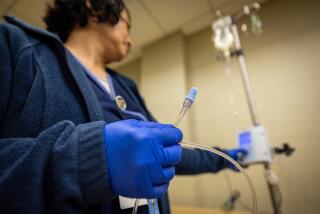A New Rx for Stroke Patients : Health: Experts are calling for drastic changes in the treatment of these ‘brain attacks,’ saying quick action can limit or even reverse neurological damage.
For Americans who suffer heart attacks, the best emergency care is available: Most arrive at a hospital within minutes; some have already received CPR. In the emergency room, medical teams pull out all the stops to minimize damage to the patient, ordering drugs, tests and treatment immediately.
Stroke patients are rarely as lucky. Many don’t get to an emergency room promptly because their families or they themselves don’t recognize that a stroke has occurred. But even if they do make it to the hospital fast, tests and treatment are often delayed because medical professionals believe little can be done to help them.
But now, medical experts say neurological damage could be drastically reduced if patients are treated aggressively within six hours of the stroke. And they are calling for a sweeping change in the treatment of stroke, the third-leading cause of death in the United States.
“I don’t think people are being neglected, but there is a general attitude that there is not much one can do for stroke. And we believe that is wrong,” says Dr. Fletcher McDowell, president of the National Stroke Assn. in Englewood, Colo.
And, says Dr. James Robertson, a neurosurgeon at the University of Tennessee: “A stroke is a ‘brain attack,’ just like a heart has a heart attack. We need to get the patient into the medical system as soon as there are symptoms.”
A stroke is a sudden disruption of blood flow to the brain, occurring when a blood vessel in the brain, or leading to the brain, is blocked or bursts. With blood failing to get through, some brain cells are deprived of oxygen, leading to a chain of chemical reactions that can result in permanent damage.
About 150,000 Americans die of stroke each year. And among the 350,000 who have strokes but survive, an estimated two-thirds are left with permanent damage, including paralysis; impaired speech, thought or senses; memory loss; distorted vision, and difficulty swallowing.
But experts now believe that much of the permanent damage to brain cells does not occur until many hours--or even days--after the stroke, and that some can be prevented with rapid intervention.
The first six hours are crucial.
“There is general acceptance that within this time frame, it is possible to reverse this damage or limit its spread,” says McDowell, who led recent efforts to develop the first national guidelines on the immediate treatment of stroke.
Backed by the American Academy of Neurology and six other prestigious organizations, the guidelines suggest family members call for an ambulance or 911 when a person begins to exhibit symptoms of stroke. But, notes McDowell, “patients are frequently unaware” what those symptoms include.
Often, a person will awaken in the morning obviously impaired. But at other times, “spells”--such as numbness on one side of the body, double vision or difficulty swallowing--will emerge briefly, then subside, says Robertson.
“These spells usually last less than five or 10 minutes,” he says. “They are painless, but they herald the onset of a major stroke. The only way to intervene is to see this as an emergency.”
However, patients with transient symptoms are often tempted “to wait and see” before seeking treatment. That’s a mistake, says Dr. Larry-Stuart Deutsch, chief of cardiovascular and interventional radiology at UC Irvine. Indeed, a 1991 Gallup survey found that 97% of consumers over age 50 do not recognize stroke warning signs.
“Stroke can occur at any time but is often first recognized in the morning,” Deutsch says. “The individual wakes up with significant neurological impairment, such as loss of movement or severe weakness on one side of the body, or serious disruption of speech or vision. A frequent response is denial.”
It is only by getting to an emergency room promptly that stroke patients can benefit from the most effective, sophisticated treatments, experts say. Then, it’s up the medical personnel to grab the opportunity to minimize damage.
The medical evaluation should begin immediately and should include a CAT scan to determine what kind of stroke has occurred, Robertson says.
“The most important thing is that the emergency room regards the problem as an emergency and that every minute counts,” adds McDowell.
Many medical centers have shown that a stroke patient can be thoroughly evaluated and treatment begun within 90 minutes, he says.
But Robertson warns: “There are many areas where stroke-care priority is considerably lower, (especially) in some busy emergency rooms on a particular night.”
Surgery for stroke patients is now common to clear a blood clot, remove blood or stop the bleeding. But too often, it is needlessly delayed, Robertson says.
Many medical centers have begun to perform surgery promptly and are beginning to use new drugs to try to restore normal blood flow or offset damage.
However, because stroke patients occasionally improve on their own, some physicians are reluctant to undertake more aggressive, risky treatment, Deutsch says.
“One of the problems is, how do you know who is going to get better on their own?” he asks. “But I think a greater number of people will get better with treatment.”
Experts say the six-hour window will become increasingly important in the next few years as more treatments become available. A wealth of drugs is being researched, including some that could prevent stroke or reduce brain damage by quickly dissolving clots.
Clot-dissolving drugs known as thrombolytic agents may reduce damage in the first six hours, but can be life threatening if they are used too late.
In a recent case, a 74-year-old Orange County woman benefited dramatically from use of the drugs. A robust and active woman, she was brought to UCI Medical Center in Orange speechless and paralyzed on her right side because of a blood clot that had formed in an artery in her brain. Her symptoms had been evident for only a few hours.
Deutsch says, “Her life was over, as far as she was concerned.”
He explained the risks of using clot-dissolving drugs to the woman’s family members and they consented to treatment. The clot was removed, and the woman received the experimental drug urokinase. When she left the hospital three days later, Deutsch says, “She basically felt 100%.”
Still, experts caution that it is too soon to suggest that thrombolytic agents should be a standard part of early stroke treatment.
“We don’t have any information as to their efficacy and safety,” McDowell says. “And it won’t be until we have studies completed that we will know. But there is much activity in this field that indicates that early treatment is effective treatment.”






